 Taylor’s Crop & Field Notes: 1/14/13
Taylor’s Crop & Field Notes: 1/14/13
Since the CSA has been on hiatus these past 4 weeks, the farm has been operating at a much more mellow pace. Many of our workers take a break during this time, which offers a nice and well deserved rest from the hustle and bustle of the Regular Season. Although the pace is slower, believe me – there’s always something to do.
During these winter months we have far fewer crops to tend to, and less attention needs to be spent irrigating them (thanks to the rain). Vegetables also grow very slowly this time of year – a combination of cold temperatures and a decreased length in daylight. With the last few weeks of particularly chilly mornings, we have been working hard to protect the tender greens (particularly small lettuce transplants) from the harsh kiss of frost by covering the plantings with a large “field blanket” we call remay. We have also been focusing our energy on harvesting for farmers’ markets, fulfilling wholesale restaurant orders, weeding winter/early spring field crops, getting busy in the greenhouse sowing spring seedlings, and planting our strawberry fields for the coming 2013 season.
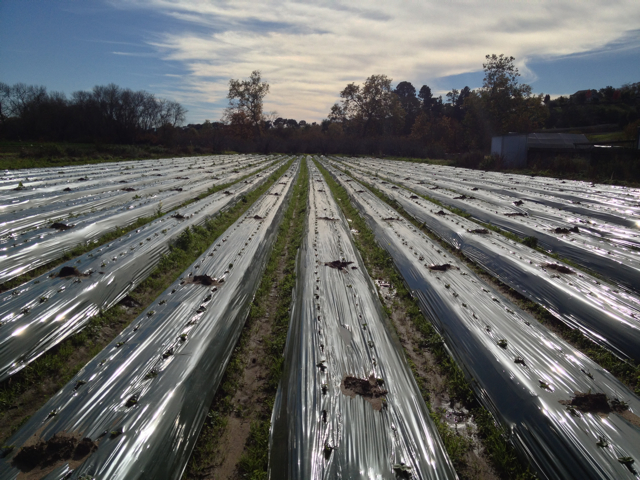
During this CSA box delivery break, we experienced A LOT of rain here on the farm. I have never seen the rivers on the farm so swollen with water. They were even overflowing in many places over the farm’s dirt roads, including the site of the 2012 u-pick dry farmed tomato fields (see picture below). Thankfully, much of the farm is in cover crop right now, so few vegetable crops were affected by the flooding. I will say that this winter – what we would call a cold and wet one – is a nice contrast to last year’s warm and dry winter. The earth needs rain, and we have certainly gotten our fair share this year and for that we can be grateful. Perhaps we may even get more?
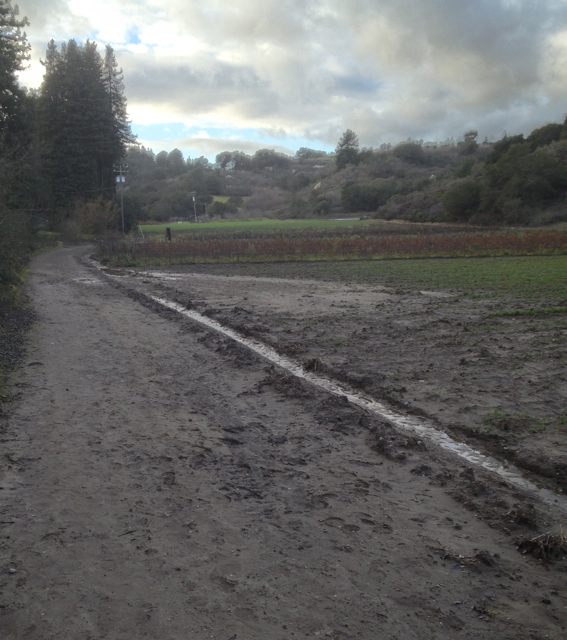
The winter break is always an appreciated relief from the non-stop action consuming the rest of the year, but I must admit it’s good to be back in the swing of things and I am glad the CSA is staring up again this week. Not to mention you all must be missing your vegetables! This week you can look forward to beautiful brussels sprouts (they are one of our best crops yet!), sweet bunched baby carrots, Butternut winter squash, a special jar of preserved tomatoes brought to you by Happy Girl Kitchen, and bunched kale (of which I can’t get enough of these days). You can look forward to a new succession of beets coming on in the next couple weeks, as well as hearty rainbow chard, heads of lettuce and broccolini. Have a great week and enjoy the winter bounty!

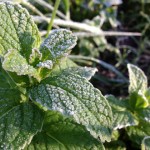 Laura’s Crop & Field Notes: 1/14/13
Laura’s Crop & Field Notes: 1/14/13
It is easy to say that winter tempers the speed of life on a farm. The rain dictates the timing and success of any transplanting that we might hope to do, and the crops that were already in the field have merely dug their roots deeper into the soil to wait out this period of low light and slow growth. However, winter’s more languid pace is also responsible for many of the season’s distinct flavors and undeniable charms.
The carrots and beets, while small, are given a superior sweetness from the recent cold-spell we’ve been experiencing; a salad that includes the decorative and delicious Winterbor kale is an excellent way to appreciate how this variety came by its name! Our long-awaited celery-root is due to be ripe in the near future, and many a delicious winter-squash soup continues to linger on the horizon. Our Meyer lemons are sweet on the trees, and nearly every day for the past few weeks, the morning has greeted me with the sight of a wide swath of frost-coated mint just outside of my door.
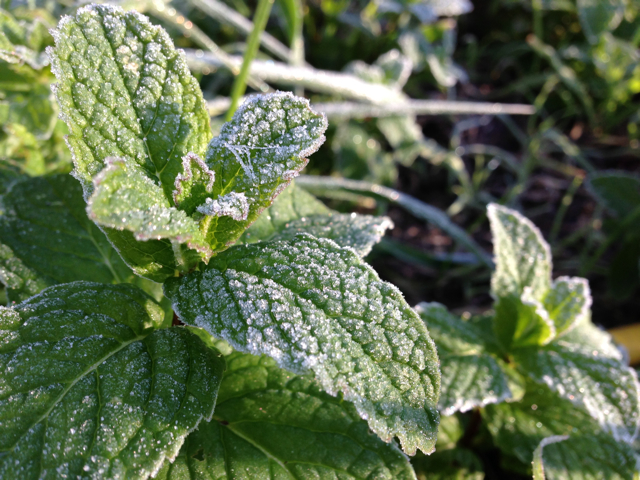
Still, winter is not all storage crops and small bunches — it’s preparation for spring! Our greenhouses are beginning to fill up again, as seedlings of lettuce, broccoli, chard, onions, and many other things are being sewn for our early plantings. Planning our crop rotations, ensuring we have our seeds queued up, and taking inventory of the necessarily tools and equipment for the coming season keep us all quite busy, even when the harvest is slower. It’s a time for preparing, and repairing, and anticipation. Goat-kids, a new flock of chicks, and a surge of spring crops will be upon us before we know it; we are doing our best to warm up and place our feet firmly at the starting line before the starting-shot of 2013 sends us racing ahead at full-speed.
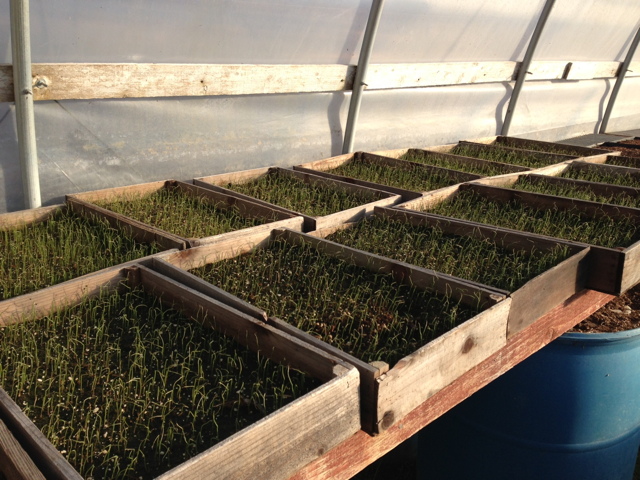
 Crop and Field Notes: 11/12/12
Crop and Field Notes: 11/12/12
Given our relatively mild climate many of our cool weather crops keep growing even during the colder winter months. The key to enjoy a continuous harvest in the winter is to plant early in the fall to give plants time to size up before the cold slows everything down. One of my favorite winter crops, the Romanesco cauliflower is finally ready for harvest this week. It’s taken more than 120 days since it was sown in the greenhouse. It’s worth the wait; in my opinion, Romanesco is one of the tastiest and most beautiful of all the cole crops. The head is pointy and, if you look closely (pull out a magnifying glass), you will see a pattern of geometric shapes that repeats itself down to smaller than can be seen with the naked eye. It has a perfect spiraling fractal pattern. The chartreuse color is unique and stays vibrant even after cooking to make a dish that is both tasty and beautiful.
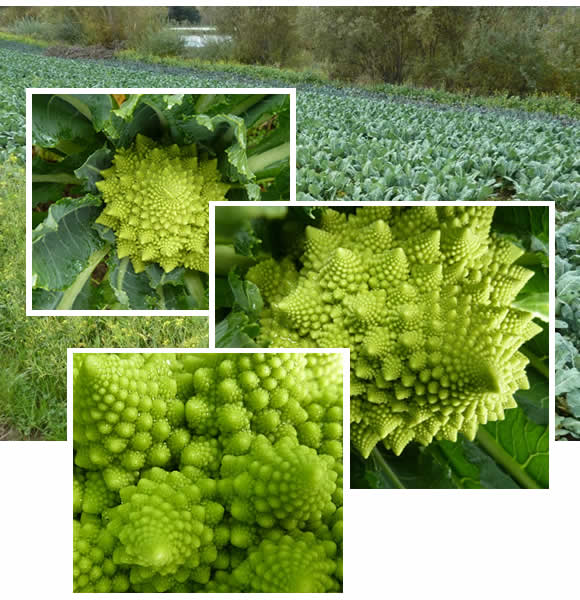 Before the first strong storms arrive we are getting the farm winter-ready. We are now cover-cropping fields that will be fallow over the winter; other fields are prepared for final plantings of fava beans, garlic and berries. The first strawberries will be planted later this week, raspberries will go in early December, and all the drainage ditches for diverting excess water need to be put in place in and around fields and farm roads.
Before the first strong storms arrive we are getting the farm winter-ready. We are now cover-cropping fields that will be fallow over the winter; other fields are prepared for final plantings of fava beans, garlic and berries. The first strawberries will be planted later this week, raspberries will go in early December, and all the drainage ditches for diverting excess water need to be put in place in and around fields and farm roads.
 Notes from the Field: 10/29/12
Notes from the Field: 10/29/12
 With Halloween at our doorstep, we are reminded that nature’s energy is once again turning inward and our popular summer crops are spent, slowly returning back to the soil. In our culture all too often we promote endless youth and growth, and avoid acknowledging the darker, dying and decomposing aspects of life, which actually hold the key to continued fertility. It’s time to remove all the stakes and twine used for trellising this year’s tomato crop; the last of the green beans will be picked this week; the Mexican corn is a reminder of summer days past; and many of the fields will be put to rest for the winter by seeding them with a legume-rich winter cover crop of purple vetch, bell-beans, peas and wheat.
With Halloween at our doorstep, we are reminded that nature’s energy is once again turning inward and our popular summer crops are spent, slowly returning back to the soil. In our culture all too often we promote endless youth and growth, and avoid acknowledging the darker, dying and decomposing aspects of life, which actually hold the key to continued fertility. It’s time to remove all the stakes and twine used for trellising this year’s tomato crop; the last of the green beans will be picked this week; the Mexican corn is a reminder of summer days past; and many of the fields will be put to rest for the winter by seeding them with a legume-rich winter cover crop of purple vetch, bell-beans, peas and wheat.
I can’t deny how I wish I could stretch out the abundance of (and increased income associated with) popular summer crops over a longer period. On the other hand, I am seeing a nice transition to our favorite cool-weather crops: the broccoli, romanesco cauliflower, butternut squash, Brussels sprouts and turnips will round out the last shares of the season. Happy Halloween!
 In the Fields: 10/15/12
In the Fields: 10/15/12
 Fall is here, a time when Fuji apples are being harvested (come and pick your own this Saturday). Bins of winter squash are being hauled in from the fields as well — the first type to go in your shares this week are the striped Delicata (pictured at right). With warm weather returning this week we may have an extended harvest of our summer favorites, but I have a feeling we are seeing the tail end of them, maybe another 3-4 weeks at the most. Right now next year’s strawberry beds are being shaped, first cover crops are being sown and the pumpkins are orange and ready for carving.
Fall is here, a time when Fuji apples are being harvested (come and pick your own this Saturday). Bins of winter squash are being hauled in from the fields as well — the first type to go in your shares this week are the striped Delicata (pictured at right). With warm weather returning this week we may have an extended harvest of our summer favorites, but I have a feeling we are seeing the tail end of them, maybe another 3-4 weeks at the most. Right now next year’s strawberry beds are being shaped, first cover crops are being sown and the pumpkins are orange and ready for carving.
– Tom
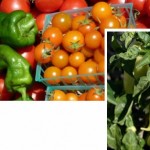 What’s Up in the Fields
What’s Up in the Fields
The first fabulous-tasting dry farmed tomatoes are here, as well as the first Yellow Hungarian and Padron peppers. Lettuce still needs to size up; should have plenty again next week. This week, arugula is abundant. Green beans: unfortunately the first three successions this year were planted in a heavier soil (higher clay content), which meant water drainage was not optimal. This resulted in the plants getting “wet feet”, which promoted the growth of a fungus which girdles the stems at the base of the the plants, stunting both growth and yield. The newer plantings are looking good though, so I am expecting that in a couple weeks we should be back to normal, harvesting large quantities and supplying all the shares. In the meantime enjoy the abundance of raspberries, blackberries and strawberries, yum!!
 Crop Updates and Member Feedback
Crop Updates and Member Feedback
We’ve reached that time of season when people get restless waiting for tomatoes, peppers and green beans. You see them in farmer’s markets, so why not in your shares? Next time you’re at a farmers market, note where the farms are located – those summer goodies are coming in from the warmer inland areas, not the coast, where we farm. As I’ve said many a time, farming and eating with the seasons is not an exact science; the ripeness and flavors of summer fruit and vegetables adhere more to mother nature’s capricious rhythms than to any date on a calendar. Yes I have heard the rumblings of “too many greens,” and “why so much kale?” (Of course I hear an equal number of rumblings from those who love having weekly greens.) Well if you aren’t a fan yet, kale has become the “queen of greens” displacing to some extend spinach (don’t worry, we are still growing spinach). Superior in nutrient richness, health benefits, and with a delicious flavor, kale is the new star. Many CSA members like it to be a staple in the shares, like carrots, and at the farmer’s markets it’s now on top of the greens “hit-list.”
As you can see from the field pictures I took recently, tomatoes, peppers, green beans, even the first eggplants are maturing, so you haven’t much longer to wait. I checked my notes: tomatoes are probably 3 weeks earlier than last year. This week we’ll start putting green beans in the shares; the sungold and dry-farmed tomatoes I predict will be in most shares in two weeks. Peppers will follow — first, the Sweet Yellow Hungarians, then the Padrons, followed by the thick-skinned red pimento peppers. One member discovered we had peppers at the farmer’s market, and as you know Taylor has been offering some through the webstore. The quantities are very limited, however, because they are the result of a small greenhouse planting we experimented with this year, to evaluate whether it’s feasible to grow peppers in the off-season (February through June). The cooler growing climate here definitely has its advantages, such as allowing us to grow both cool and heat-loving crops side by side (broccoli, arugula, and spinach next to peppers and tomatoes). But it also asks us to have patience in early summer. This patience pays off though: typically we are rewarded with a long frost-free growing season into late fall, so we often still have peppers, tomatoes, and green beans into early November.
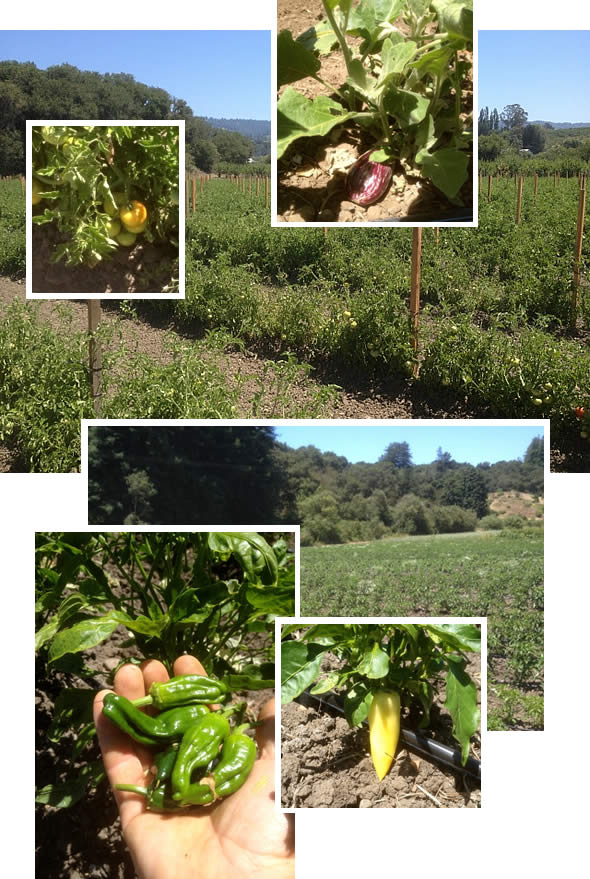 Iceberg lettuce has a bad reputation, many of us grew up with it and consider it unappealing and tasteless, serving no other purpose than as a carrier for rich creamy salad dressings. So last week I was asked why would even consider growing it. I wanted to experiment with though, because some members and market customers expressed an interest, and during a farm conference earlier in the year I spoke with a farmer who mentioned how popular it was among his members. So I tried it for the heck of it, and to compare it with our regular lettuce varieties. It turns out it is not well liked within our community of eaters, myself included. We only have two small plantings left in the field, so after they’re done I will discontinue it.
Iceberg lettuce has a bad reputation, many of us grew up with it and consider it unappealing and tasteless, serving no other purpose than as a carrier for rich creamy salad dressings. So last week I was asked why would even consider growing it. I wanted to experiment with though, because some members and market customers expressed an interest, and during a farm conference earlier in the year I spoke with a farmer who mentioned how popular it was among his members. So I tried it for the heck of it, and to compare it with our regular lettuce varieties. It turns out it is not well liked within our community of eaters, myself included. We only have two small plantings left in the field, so after they’re done I will discontinue it.
Another member inquiry was about the red carrots we put in last week’s shares. Like their purple cousins, they don’t match up in flavor and sweetness to the orange ones. They do, however, have a strong carrot-y taste, with a hint of bitterness. Again, these are new varieties we’ve been experimenting with and I am glad to get your feedback. I will grow colored carrots on a very limited scale, and mainly focus on the more popular orange varieties such as Mokum and Nelson.
A frequently asked question regarding the Extra Fruit Option is whether there will be fruit other than just strawberries. The answer is definitely yes. Last week we mixed it up with plums, apricots and caneberries (blackberries and raspberries). We will continue to do this as long as the other varieties last. Strawberries are a production staple, lasting most of the season; blackberries and raspberries are close runners-up in terms of production; stone fruits have the shortest season. (Then there are apples and pears… but that’s fall, and we’re not there yet.) Unfortunately there was only a very small apricot harvest this year due to poor fruit set caused by untimely spring rains right during the peak of bloom. We will be combining them with the plums. Plums had a better fruit set and so should last a little longer, and blackberries and raspberries are picking up again and will be a regular item in the fruit shares.
Eating with the seasons is not only a great way to learn the rhythm of crop cycles, but you also learn about crop growing practices and the challenges that go along with them; we learn to embrace the imperfections instead of expect picture-perfect aesthetics like those developed for supermarkets [often at a loss of flavor — see a very timely article from last week’s San Jose Mercury News, “Researchers reveal secret behind tasteless tomatoes” – Debbie]. Ultimately, eating what is grown on your local farm is a way to expand your horizons beyond grocery store fare — and experience how your food is produced in the process. If we see farms as an opportunity to establish a relationship with the people who grow our food, we can, I am convinced, directly improve the vitality of the place we live in, our personal health and that of our community.
– Tom
 Update from the Fields
Update from the Fields
With temperatures well into the 90s this week, last week’s rain seems a distant memory. The longer that our cool and foggy “coastal summer” weather can be delayed, however, the sooner we’ll be able to enjoy our favorite summer crops: tomatoes, peppers, eggplant and green beans. We are at the cusp of getting started with our caneberry harvest; some shares will be getting the first blackberries this week and raspberries are not far behind. The spinach is looking really nice; broccoli, lettuce and leafy greens continue in abundance. With squash, pickling cucumbers and basil in the shares, you know that summer is imminent. But why aren’t there any tomatoes if we have basil already? Fair question! Since basil grows a lot faster than tomatoes, we planted a couple successions of it. This is only the first planting; by the time the tomatoes kick in, sometime in July, we should have another planting of basil ready for harvest.
It’s going to be a busy week; in addition to getting the farm ready for our Solstice Celebration (see below), we are planting a large block of winter squash. No I am not delirious, it’s just that most of the varieties we plant take over 100 days to mature, so we have to think ahead (way ahead). The last succession of tomatoes just got planted. We are falling behind on thinning our Fuji apples, however all the Galas are done and sizing up nicely. Weeding is getting under control, but lots of tomatoes need to be tied and trellised.
But this Saturday we are taking a short break from field work for our 17th Annual Live Earth Farm Solstice Celebration. We hope you will take a break too, from whatever you’re doing, and join us! This event is always lots of fun. After the tractor rides, you’ll likely find me dancing around the fire to Kuzanga Marimba’s amazing tunes and rhythms. And once night settles in we will have a surprise performance by one of our long ago farm interns – so stick around, you won’t want to miss it!


